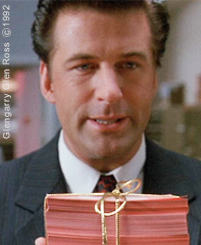Did the leads come in yet?
I used to work in sales for one of the world’s largest consulting companies. Every year we participated in several large trade shows, such as Oracle World, SAP Sapphire, and NRF. Preparing for these events took incredible time and energy. The business case for participating in these events was lead generation (along with the guns that Oracle and SAP held to their partners’ heads).
We armed our booth with several wireless scanners so we could scan the badges of the throngs of convention attendees who passed by. We tried scan as many people as possible. More leads meant a better event, right?
We always offered some sort of sexy high tech gadget as a prize to attract people to our booth. Free iPods, Bose headphones, we offered whatever was the hot gadget that year, we promoted the drawing to drive more people to our booth. Now mind you, 90% of the people who stopped by our booth came by just to enter the contest. They had no interest in discussing our services, and they did not stick around to chat or even pretend that they had an interest in anything other than the prize.
 Meanwhile, back in the sales offices, the direct sales teams were anxiously awaiting the new leads from the big event. It reminded me of the film, Glengarry Glen Ross. “Did the leads come in yet?” “When are the Glengarry leads arriving?” As if, somehow these “leads” were going to develop into hot opportunities or closed deals. What would happen once these leads did finally arrive? The sales team would call the contacts, or at least some of them. Little, if anything developed, and the sales team would proclaim the leads a total bust. As Jack Lemon complained in Glengarry Glen Ross, “The leads are weak!”
Meanwhile, back in the sales offices, the direct sales teams were anxiously awaiting the new leads from the big event. It reminded me of the film, Glengarry Glen Ross. “Did the leads come in yet?” “When are the Glengarry leads arriving?” As if, somehow these “leads” were going to develop into hot opportunities or closed deals. What would happen once these leads did finally arrive? The sales team would call the contacts, or at least some of them. Little, if anything developed, and the sales team would proclaim the leads a total bust. As Jack Lemon complained in Glengarry Glen Ross, “The leads are weak!”
In reality, these leads were little more than an attendee list. Mind you, they did have value. Companies send the attendees to those huge Oracle or SAP events for a reason. Attendees likely have something to do with the ERP or CRM system at their companies.
However, are these badge scans “sales ready”? Not even close. It’s a waste of money to hand these “leads” over to the direct sales team at this point.
What’s a better approach for trade show leads?
Trade show leads like these, where no real conversation took place at the booth, should be included in a Lead Nurturing Campaign. Some of these badge scans may eventually develop into real opportunities, but the vast majority of them are not sales ready at this point.
A nurturing campaign can be used to try to develop a dialog with each contact. By offering prospects useful content that is educational (not salesy) you can patiently progress the prospects to the point when they are ready to be passed over to direct sales. A lead nurturing campaign is a better method to ensure that all contacts are patiently and consistently contacted with something of value offered with each contact. Compare this to the typical sales rep calling once a month with a “just checking in” voice mail message.
Furthermore, nurturing campaigns can be conducted for a fraction of the cost that it takes to have a direct sales team handle the leads.
Once a contact has responded positively to a few of your nurture campaign emails by clicking through the emails to download white papers or to attend a webinar, they may be more receptive to a call from direct sales. They may even initiate contact on their own. Your direct sales team will thank you for developing the “lousy leads” into legitimate prospects.
Is your company still sending attendee lists from trade shows to direct sales and calling them leads? Are you using inbound marketing services to follow-up on trade show leads? We’d love to hear about your experiences.
